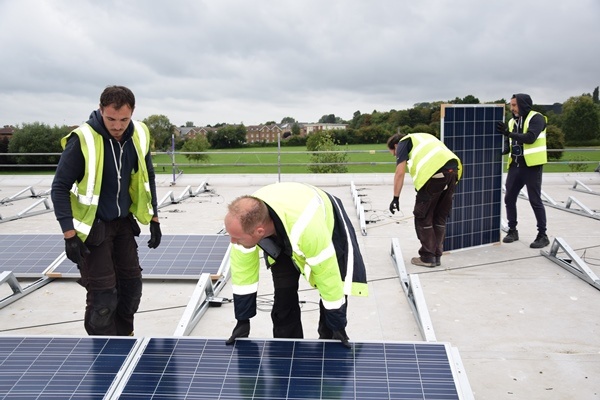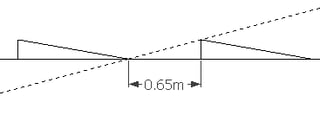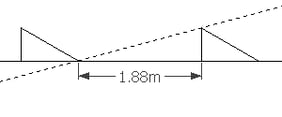Driving around business parks and industrial estates (as I do...), I am frequently struck by how many flat roofed industrial buildings there are, and how few of them have solar panels on them.
Flat roof solar tends to cost slightly more than sloping roof solar, but it's still worth doing - payback times of 7-9 years are typical, versus an expected life of 20-30 years.
In simple terms the lifetime cost per kWh generated is around 4.5p. With the Feed-in Tariff subsidy that falls to around 3p per kWh!
You really should want one...
3p per kWh is pretty amazing, particularly when compared to a grid cost of 10-15p per kWh and rising. So if your premises has a flat roof, don't dismiss it. Call us and we'll assess the viability of the installation for you.
In the mean time, here are a few key things to be aware of, including the optimal panel slope, the optimal orientation, fixing type, ballast, and roof warranties.
Considerations for flat roof solar
- Flat roof solar is usually 'free-standing' on the roof. The mounting frames are not secured to the roof and therefore the system has to be weighted down using ballast. The structure of the roof needs to be able to support the ballast.
- To mimimise ballast and optimise space, panels are usually mounted at an angle of 10-12 degrees to the horizontal, as opposed to the 'UK optimal' angle of 30-40 degrees (see below).
- Roof warranties. It is important that the system does not compromise the roof warranty. Most roof warranties are compatible with a free-standing, ballasted solar system. But with some roof types and membranes - e.g. Bauder roofs - a specialist fixing system may need to be used. If the system is fixed to the roof, it is important to check the impact on the roof warranty and to ensure water tightness is maintained.
- Roof condition. Before installing solar it is important to make sure that the roof is in a good condition. It's clearly easier to take 'free-standing' panels off a flat roof than it is to take bolted panels off a sloping roof, and on a flat roof upgrade a few years into the solar system installation won't actually be too disruptive. That said, if your flat roof uses standard roof felt, it would be worth ensuring it's in tip top condition before installing solar.
Some felt roofing can melt in the summer heat and then become brittle in lower winter temperatures. It can also be affected by UV rays. It therefore tends to develop leaks and needs replacing every 10 years or so. It may be worth upgrading the roof membrane ahead of installation - these days there are maintenance free membranes that are guaranteed for 15-20 years and should last 30 years.
Optimal mounting angle for solar panels on a flat roof
One of the most common areas of misunderstanding surrounding flat roof solar installations is the panel mounting angle.
Solar panels (in the UK) produce most power when mounted at between 30 and 40 degrees to the horizontal, facing due south. It is therefore natural to assume that this is the best angle to tilt them at for flat roof installations. But this is not usually the case, as there are other factors that come into play with flat roof mounting:
- Wind loading The greater the tilt angle, the higher off the roof the panels will stand. This means more ballast and stronger frames and fixings are required due to increased wind loads; as a result, it becomes increasingly more expensive to install at steeper inclinations. In many cases, the ballast requirement for panels mounted at 30 degrees would be prohibitive - the roof structure was simply never designed to take the additional load.
- Row separation As you increase the mounting angle, the spacing required between rows to prevent shading increases (see drawings below). Systems with steeper mounting angles therefore take up more space. Thus, as can be seen from the table below, the output per m2 is actually much higher by utilising a shallower slope.
|
Shade footprint of panels at 10 degrees (left) and 30 degrees (right), with sun at 15 degrees. |
Mounting the panels below 30 degrees helps to minimise wind uplift and roof loading, and maximise the number of panels for a given roof space.
A mounting angle of 10 degrees generally offers the optimum compromise between performance, ballast requirement, area required and installation cost.

Output data for London.
As the table shows, panels mounted at 10 degrees will yield between 52% and 72% more power per unit area of roof space (once the spacing required between rows is taken into account).
Optimal panel orientation for flat roof solar
As mentioned above, solar panels installed in the UK will produce most power when angled between 30 and 40 degrees and facing due south. But what if your roof doesn't face due south? Should the panels be rotated to face south anyway? Or what about an east/west configuration?
South-facing systems
As with a pitched roof installation, solar panels on a flat roof can be orientated as much as 90 degrees off south, to face directly east or west, and still be worthwhile considering in terms of output performance.
It is usually best to orientate the panels in line with the footprint of the building in order to achieve the optimum number of panels within the roof area. There is little benefit in rotating the array to face due south as this leaves dead space that could otherwise be used to fit more panels. See pictures below.
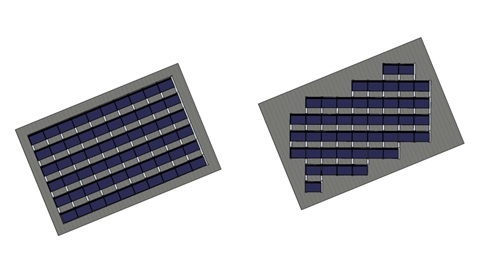
In line with roof vs due south panel layouts for flat roof.
In the above example we can get 30% more panels by installing in line with the roof footprint (allowing for suitable edge distances). This contrasts with just a 0.5% drop in output due to the less favourable orientation (20 degrees off south).
It is worth highlighting that at a 10 degree pitch, the difference in output between panels mounted due south and panels mounted east or west is much lower than it is for a system pitched at 30 degrees - see table above.
East/West systems
For buildings with footprints aligned roughly south, another mounting option to consider is an east/west configured system. These use the same A-frames, tilted at 10 degrees, as with the south-facing systems, but set back to back so that the panels are orientated at 180 degrees from each other (due east and west ideally).
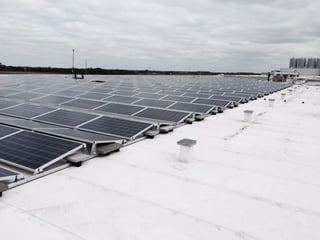
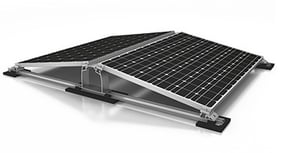
East/West systems maximise the power output (number of panels) per square meter of roof, since no spaces are required between rows. The lower performance of the individual panels due to the less favourable orientation is therefore offset by the extra capacity. On a per unit area basis, a 10 degree east/west system outperforms a 10 degree south-facing system by up to ~25%.
On top of the performance benefits, east/west systems also require lower ballast. However, because of the reduced performance on the individual panel level, east/west systems are more expensive per kWh than south-facing systems. Despite this, providing the building footprint can accomodate an orientation as close to east-west as possible, an east/west mounting system is usually preferable for the other reasons outlined above.
Fixed or ballasted?
In most situations, a free-standing ballasted flat roof solar mounting frame is preferable. Using a free-standing mounting system weighed down with ballast, avoids the need to penetrate the roof surface. This helps to minimise the risk of roof leakage, and ensures that any warranties on the watertightness of the roof aren’t compromised – particularly important if your roof is brand new.
With ballasted systems, the solar mounting frames rest on special rubber footings to help spread the load. The ballast itself comes in many forms, and preference may vary from installer to installer. At Spirit we use preformed concrete ballast as it looks neat and tidy and will stand the test of time.
In some cases, however, ballasting isn’t a viable option; for example, if the roof cannot take the weight of the ballast, or where the ballast requirement is so high (e.g. tall buildings) that there is not enough space under the panels to fit it all! There may be no choice but to fix directly to the structure of the roof. This is more complicated than using ballast as input from the roofing manufacturer is usually required to ensure that the fixings are adequately sealed against water ingress. There are systems available but they usually require a new roof covering and they can be quite expensive.
The choice of fixing will depend on the roof system manufacturer - they often have their own specialist fixing. Other universal fixings exist; please get in touch for more information.
If you have a project in mind, we can compare systems at different orientations to ensure the best system is specified from the outset. Please call us on 0118 951 4490, email commercial@spiritenergy.co.uk with project details, or request a free quote:
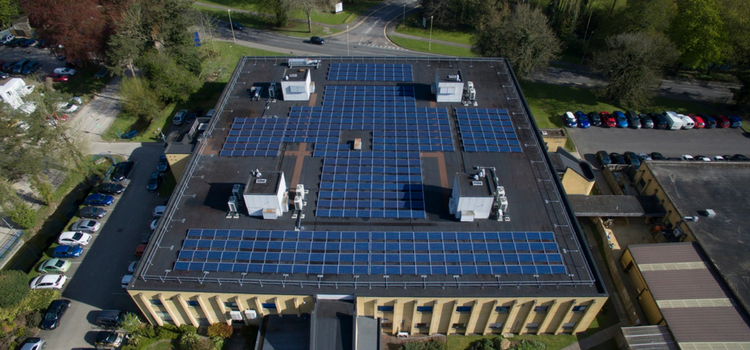
100kWp flat roof solar system installed by Spirit Energy at Andover College, Hampshire.




